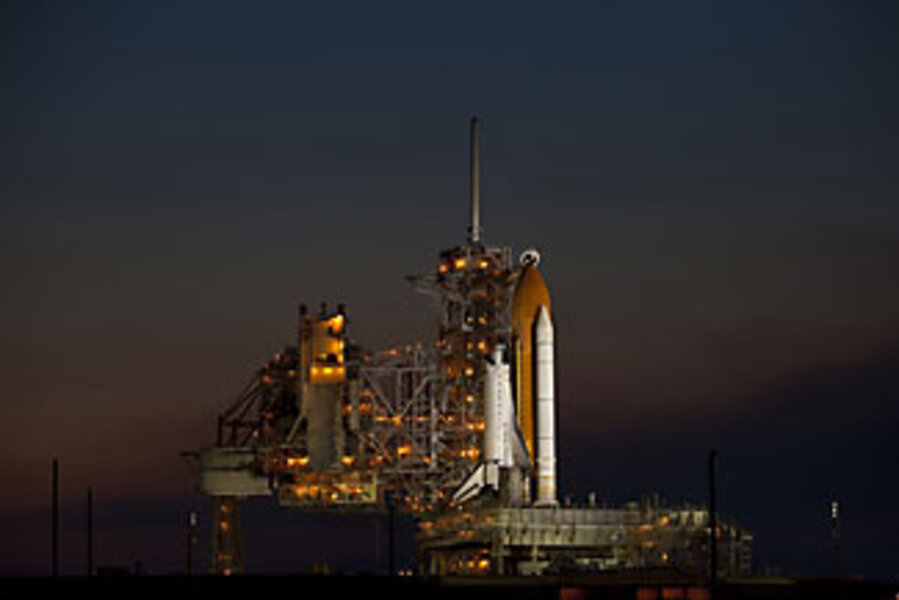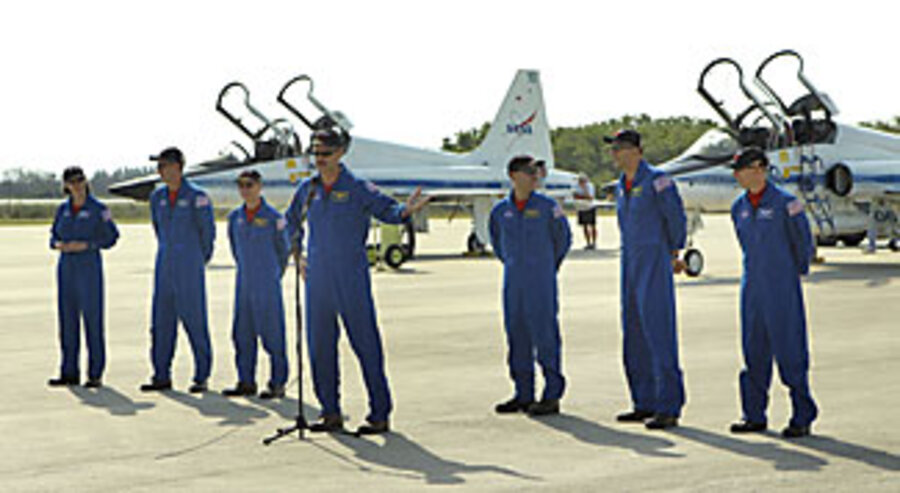Shuttle's risky mission to repair Hubble
For 19 years the Hubble Space Telescope has provided mankind with extraordinary views of the universe. It now awaits the launch of one of the most extraordinary space-shuttle missions in history.
Monday afternoon, the shuttle Atlantis and its seven-member crew are set to lift off from the Kennedy Space Center in Florida for a fifth and final house call to Hubble – an astronomical icon that has revolutionized humanity's understanding of the cosmos and served as NASA's most consistent, high-profile ambassador for space exploration.
During Atlantis's 12-day mission, astronauts are slated to repair Hubble components that failed last September, undercutting the telescope's capabilities. They will also wrestle two new instruments into place – upgrades that will keep the observatory on the cutting edge of astronomy and astrophysics for several more years – and perform maintenance tasks.
A delayed mission
For a telescope designed for servicing every three years or so, this mission is long overdue. It was canceled after the loss of the shuttle Columbia and its crew in 2003, only to be revived amid public pressure and after planners persuaded former NASA administrator Michael Griffin that the mission could be flown at an acceptable risk. The shuttle program could not afford to lose another orbiter and crew and still keep its international commitments to complete the space station.
The last flight to the orbiting observatory took place seven years ago. "Hubble needs a hug," quipped mission specialist John Grunsfeld during a recent briefing. He's making his third consecutive trip to the telescope.
What a hug. If all goes as planned, "the Hubble Space Telescope will be at the apex of its capabilities," says David Leckrone, the senior project scientist for Hubble at NASA's Goddard Space Flight Center in Greenbelt, Md. A new wide-field camera will enable astronomers to observe the 13.6-billion-year-old universe when it was a scant 500 million years old. That shaves some 200 million years off the youngest objects Hubble can spot today.
The camera will be able to observe objects near and far at wavelengths ranging from ultraviolet light through visible light to near-infrared radiation. The capability is expected to yield new insights into areas ranging from the evolution of stars to the evolution of galaxies at a broad span of distances. By mapping this matter and its make-up, astrophysicists hope to track how the chemical composition of galaxies changes with time.
In addition, astronauts are slated to install a new spectrograph that will reveal the composition of matter in visible, web-like filaments of gas, galaxies, and galaxy clusters. These gather and glow to mark the boundaries of vast voids in the cosmos, the largest-scale structures in the universe.
Custom-designed tools to make repairs
Unlike the four previous servicing missions, however, astronauts will be making detailed repairs on components not designed for on-orbit servicing. A space-station construction mission has spacewalkers wielding wrenches and connecting large cables. Some of the spacewalkers on this mission will be standing inside the telescope's bays, working in tight quarters with small fasteners and circuit-board modules.
The crew's toolkit testifies to the job's unique nature of the task. Of the 180 tools the crew is carrying, 116 were custom-designed for this house call.
There is little or no margin for error.
"There won't be any next chance to do things that we don't get accomplished," says Preston Burch, Hubble program manager at the Goddard Space Flight Center. With five back-to-back days of spacewalks and a tightly packed timeline for finishing tasks, this trip is the most challenging servicing mission that shuttle astronauts have ever faced, he adds.
Riskier than a space-station mission
The mission also hovers near the boundary of acceptable risk to the orbiter and crew.
A mile and a half away from Atlantis's Pad 39-A, the shuttle Endeavour sits poised on Pad 39-B. If needed, it will carry a four-member crew to bring the Hubble repair crew home in case space junk or micrometeroids inflict irreparable damage to Atlantis's thermal protection system. Not since the Skylab missions in the mid 1970s has NASA kept rockets at the ready for a rescue.
The thermal-protection system safeguards the shuttle and its crew from the heat of reentry. The system consists of heat-shedding tiles on the orbiter's underside and heat-resistant material covering the nose and the leading edges of the wings and tail. Damage to the system from debris strikes at liftoff led to the Columbia disaster in 2003 as the craft reentered the atmosphere.
Hubble's orbit won't allow Atlantis to reach the safe haven of the space station if a debris strike proves too serious to patch.
Leroy Cain, NASA's deputy shuttle program manager, puts some numbers to the risk. The agency uses one chance in 200 of catastrophic damage as a benchmark, he says. Higher risks are classified as "probable" catastrophic loss of orbiter or crew. Lower risks get dubbed "remote."
A typical flight to the space station carries a risk of between one chance in the low 300s to one chance in the high 200s of catastrophic damage, he explains. As late as mid April, however, mission planners were looking at an average risk of about one in 185 for the Hubble mission, putting it in the probable column.
But planners nudged the risk into the "remote" column by having Atlantis scurry to a lower, less debris-strewn orbit once the crew finishes with Hubble. And while Atlantis has Hubble locked to a servicing frame in its cargo bay, the shuttle will orbit tail first and cargo bay down. Planners say that will help protect the nose and leading edges of wings and tail from potential collision damage.
Toss those changes into the mix, and the latest risk number stands at one chance in 229 of catastrophic damage, according to John Shannon, the shuttle's program director. That's still greater than a trip to the space station. But it also falls just on the upbeat side of the border between probable and remote.
Plans for a rescue, just in case
If a rescue becomes necessary, Endeavour will launch and rendezvous with Atlantis in its lower, post-repair orbit. Oriented nose to tail and payload bay over payload bay, Endeavour's crew will reach out to Atlantis with the shuttle's robotic arm and grapple to a fixture on Atlantis's arm.
The rescue would involve stringing a tether along the robotic arm, then moving the crew across in three spacewalks over two days. It also would involve a transfer of all seven crew reentry suits from Atlantis to Endeavour. All the spacewalking would be done by Atlantis's crew, with Dr. Grunsfeld acting as choreographer for the first two sets of evacuations.
The day after Endeavour arrives, Grunsfeld would transfer suits and shepherd two crew members across the gap.
On the second day, Grunsfeld would shepherd two more crew members across. After a 4-1/2-hour break, one of those, mission specialist Mike Massimino, would return to Atlantis and act as guide for the last two crew members, including the commander. Before leaving, the commander would ensure enough systems remain operating on Atlantis to allow controllers on the ground to guide it to a reentry and splash down in the Pacific Ocean.






